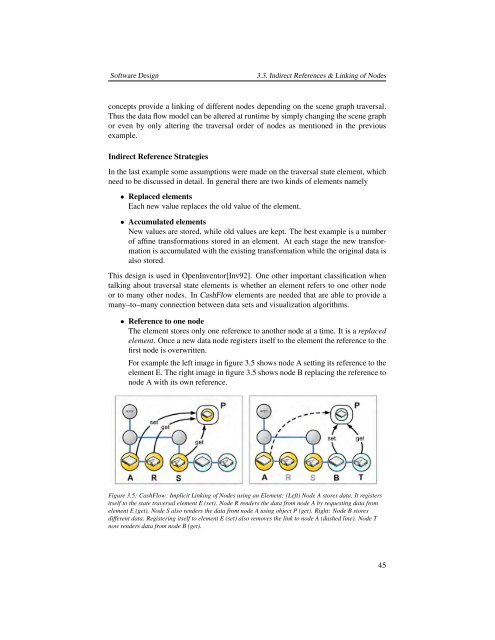CashFlow, A Visualization Framework for 3D Flow - Studierstube ...
CashFlow, A Visualization Framework for 3D Flow - Studierstube ...
CashFlow, A Visualization Framework for 3D Flow - Studierstube ...
- No tags were found...
Create successful ePaper yourself
Turn your PDF publications into a flip-book with our unique Google optimized e-Paper software.
Software Design3.3. Indirect References & Linking of Nodesconcepts provide a linking of different nodes depending on the scene graph traversal.Thus the data flow model can be altered at runtime by simply changing the scene graphor even by only altering the traversal order of nodes as mentioned in the previousexample.Indirect Reference StrategiesIn the last example some assumptions were made on the traversal state element, whichneed to be discussed in detail. In general there are two kinds of elements namely• Replaced elementsEach new value replaces the old value of the element.• Accumulated elementsNew values are stored, while old values are kept. The best example is a numberof affine trans<strong>for</strong>mations stored in an element. At each stage the new trans<strong>for</strong>mationis accumulated with the existing trans<strong>for</strong>mation while the original data isalso stored.This design is used in OpenInventor[Inv92]. One other important classification whentalking about traversal state elements is whether an element refers to one other nodeor to many other nodes. In <strong>Cash<strong>Flow</strong></strong> elements are needed that are able to provide amany–to–many connection between data sets and visualization algorithms.• Reference to one nodeThe element stores only one reference to another node at a time. It is a replacedelement. Once a new data node registers itself to the element the reference to thefirst node is overwritten.For example the left image in figure 3.5 shows node A setting its reference to theelement E. The right image in figure 3.5 shows node B replacing the reference tonode A with its own reference.Figure 3.5: <strong>Cash<strong>Flow</strong></strong>: Implicit Linking of Nodes using an Element: (Left) Node A stores data. It registersitself to the state traversal element E (set). Node R renders the data from node A by requesting data fromelement E (get). Node S also renders the data from node A using object P (get). Right: Node B storesdifferent data. Registering itself to element E (set) also removes the link to node A (dashed line). Node Tnow renders data from node B (get).45





